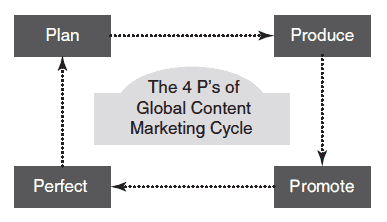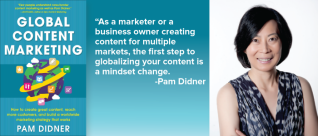With the ever-growing adoption of content marketing and further globalization of communications and marketing, it seems unavoidable that content marketing needs to stretch beyond borders. Pam’s book is a great way to start if you’re interested in content marketing strategies on an international level. I got to ask her a few questions…
International Content Marketing is one of my favorite topics. Not surprising you might say, since I studied international marketing and have a multicultural background. All the books, blogs and papers I had read so far had one thing in common: it was always mostly based on an American business philosophy or even data. However, businesses who want to implement Content Marketing on an international scale can’t just rely on the fact that language is the only barrier to cross.
A few months ago, I came across Pam Didner’s blog. To my knowledge she’s the only expert in both Content Marketing and International Marketing combined, so I put the feed in my „special attention“ list. When her book „Global Content Marketing“ came out a few weeks ago, I just had to purchase it.
Global Content Marketing – Who’s behind it?
 The author of the book, Pam Didner, has led Intel’s worldwide product launches and marketing campaigns and „provided strategic guidance on audience development, messaging architecture, editorial planning, content creation media buys and social media outreach on a global scale.“
The author of the book, Pam Didner, has led Intel’s worldwide product launches and marketing campaigns and „provided strategic guidance on audience development, messaging architecture, editorial planning, content creation media buys and social media outreach on a global scale.“
I had high expectations for this book, therefore I did not think it could really delight me (ever heard of the confirmation-disconfirmation paradigm?). However, as soon as I read the first pages, I knew this was what I had been looking for to connect dots between international marketing and Content Marketing.
Rather than summarizing what the book will teach you, you’ll find plenty of other articles doing that already, I thought I’d dig a little deeper. So I asked Pam a few questions on Global Content Marketing.
„Management has the perception that content marketing requires no budget and little resources. If you are committed to content marketing, you must allocate budget and resources accordingly.“ – Pam Didner
Pam, what are the most frequent mistakes companies make when it comes to going global with content marketing?
Rather than a mistake; it’s more of an oversight. Having a strategy is important, but having a strategy with the local team’s buy-in is even more vital. Working together to align on objectives and goals and acting with clear roles and responsibilities are the key requirements for global content marketing.
Another oversight is budget. Management has the perception that content marketing requires no budget and little resources. On the contrary, it requires a certain amount of resources and budgets to do correctly. If you are committed to content marketing, you must allocate budget and resources accordingly.
[Tweet „If you are committed to content marketing, you must allocate budget and resources accordingly.“]
Content Marketing is being adopted by more and more brands globally but which brands do an outstanding job on an international level?
Most global (large and small) companies are doing some level of content marketing in a ‘hub and spoke’ manner. A typical ‘hub and spoke’ model is on in which a brand management team has a website ‘hub’ which houses a main cache of content and then distributes and repurposes relevant content to different marketing channels. A couple of companies that come to mind are Evernote and Birchbox.
Evernote offers a multiple language versions of a standardized suite of note-taking apps that sync across multiple devices in the cloud. Rather than broad marketing, their marketing focuses on highlighting the benefits and features of their products and services. They educate their customers in the creative ways to use Evernote and offer tips to save time. The company uses a mix of corporate and locally customized content including videos and articles on its blog to increase customer productivity. Their content is available in 14 different languages, varying by country. Corporate provides the style guide and website templates, and the local teams source and determine the right content to create or localize.
 Birchbox, a subscription-based e-commerce service, sends its subscribers a box of beauty and grooming-product samples each month. Hopefully by using the samples, its customers will ultimately buy full-sized versions. The company expanded globally in 2012 after acquiring a Paris-based competitor, opening up markets in France, Spain and the UK—three countries with distinctly nuanced tastes and cultural preferences. Since the samples differ by country, right from the start the content for each had to be completely different. They create original, useful and educational content for their websites, then promote that content using social media channels to drive traffic back to the sites and encourage subscriptions.
Birchbox, a subscription-based e-commerce service, sends its subscribers a box of beauty and grooming-product samples each month. Hopefully by using the samples, its customers will ultimately buy full-sized versions. The company expanded globally in 2012 after acquiring a Paris-based competitor, opening up markets in France, Spain and the UK—three countries with distinctly nuanced tastes and cultural preferences. Since the samples differ by country, right from the start the content for each had to be completely different. They create original, useful and educational content for their websites, then promote that content using social media channels to drive traffic back to the sites and encourage subscriptions.
None of them have big budgets, yet they make it work by creating and sharing fun, educational and useful content. They create content with their customers in mind. Of course, having great offerings is a must.
Do you think international CM strategies are going to be adopted by many companies in 2015? Or rather within the next 5 years? Which skills do these companies lack most / what are the challenges?
You may not see any organizations tout ‘global content marketing strategy’ as a main core competency, but it has been adapted and implemented in bits and pieces within organizations. The biggest challenges are that current marketing organizational structure and budget allocations are not set up to fully implement content marketing efforts. Proper organization structures with appropriate talent and skills are essential. As described in my book, Global Content Marketing, you need to hire people and agencies that can execute the 4 P’s of the Global Content Marketing cycle: plan, produce, promote, measure and optimize content.
[Tweet „#ContentMarketing – Proper organization structures with appropriate talent and skills are essential“]

Clearly, the book is intended for marketing professionals who know their stuff in both „disciplines.“ If you’ve ever faced challenges related to an international expansion and you’ve acquired the basics of content marketing, this book will be your new bible which connects the dots. I especially like how Pam made the book relevant for readers of different audiences – at the end of each chapter, you’ll find a summary and the implications for:
- Small businesses and entrepreneurs
- Enterprise Marketing Managers
- And agencies and marketing consultants.
A great read! I’m happy to recommend Pam’s book to all of you!
Want more information on the book? Just check out the Website dedicated to the book. You can follow Pam on Twitter, SlideShare and on Facebook.



